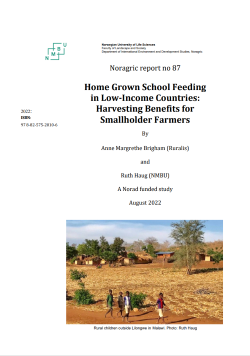Noragric report no 87 Home Grown School Feeding in Low-Income Countries: Harvesting Benefits for Smallholder Farmers
About the publication
- Published: October 2022
- Series: --
- Type: --
- Carried out by: Anne Margrethe Brigham (Ruralis) and Ruth Haug (NMBU)
- Commissioned by: Norad
- Country: --
- Theme: --
- Pages: 27
- Serial number: --
- ISBN: 97 8-82-575-2010-6
- ISSN: --

Introduction
Against the backdrop of widespread poverty and food insecurity in Low and Middle-Income Countries (LMICs) and the fact that most of the populations of these countries rely on agriculture for a living, the concept of Home-Grown School Feeding (HGSF) grew out of three interconnected realizations.
The first was that isolated, sector specific, interventions often fail to realize the intended goals because a more wholistic approach is needed. The second was that agricultural interventions intended to improve incomes and food and nutrition security (FNS) of smallholder in LMICs often fell
short of their aspirations because farmers that were helped to increase productivity and produce a marketable surplus, lacked a market on which to sell this (AU and AUDA-NEPAD 2022: 19). Lastly, school feeding (SF)—an intervention generally successful in improving nutrition, health, and
educational outcomes for children—was at best an untapped market for local smallholder farmers, but at worst undermined local agricultural development because the programs often relied heavily on imported or donated food from abroad that displaced local production (GCNF 2019: 36; WFP 2013; Gelli et al. 2010: 3; Bundy et al. 2009). The promise of HGSF is to reduce poverty and food insecurity by buying school food locally, thereby providing a new and stable market for smallholder farmers.
HGSF is a wholistic and cross-sectoral approach that has potential benefits across the sectors of education, health, social protection, and agriculture. It can provide direct benefits for education through increased attendance, especially of girls, and indirect benefits for education through improvements in health that in turn benefit cognition and learning (Bundy et al. 2018: xxi). The programs can also improve health directly through better diet quality and quantity, and provide investments in local economies, first, as a safety net (with a transfer value of about 10% to 15% of income), and second, through the local purchase of food which stimulates agricultural production (ibid).
HGSF started to take root as a policy to reduce poverty and improve FSN in LMICs around the turn of the 21st century (FAO and WFP 2018: 5; Bundy et al. 2018). For instance, in 2003, the New Partnership for African Development (NEPAD) Secretariat under the Comprehensive Africa Agriculture Development Program (CAADP) endorsed HGSF as one of the strategic programs of AUDA-NEPAD (AU and AUDA-NEPAD 2022: 5) and in 2005 the World Summit Outcome document promoted HGSF as one of four “quick-impact initiatives” and recommended that local school meal programs, using home-grown foods where possible, should be implemented to achieve the Millennium Development Goals (Cruz 2020: 36). At the UN Food Systems Summit in 2021, a “Global School Meals Coalition” was formed and joined by 55 development organizations and 61 countries, 3 including Norway (WFP 2021: 1). In addition to encouraging the spread of school meals to the most vulnerable children across the globe, one of the main objectives of the School Meals Coalition is “promoting safe, nutritious and sustainably produced food, and provide balanced diets linked to local and seasonal production, where appropriate” (AC and AUDA-NEPAD 2022: 15).
This report studies the potential and realized benefits of HGSF in LICs. We focus on the extent to which these programs contribute to strengthening smallholder farmers' food security and nutrition as well as incomes. Furthermore, we shed light on the cost of HGSF and how these programs can become financially sustainable if, or when, external financial support diminishes. We do this by a desk review of literature on HGSF in LMICs and by interviewing key informants in the major international organizations, bilateral organizations and NGOs within School Feeding (SF) in these countries. In addition, we take a closer look at the HGSF programs in two of Norway’s partner countries for long term development: Malawi and Ghana. These two countries, with SF programs that share some important characteristics but differ in others, are used to shed light on the successes and challenges in molding context-specific programs and bringing them up to scale.
